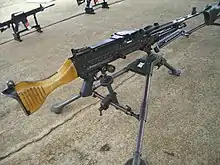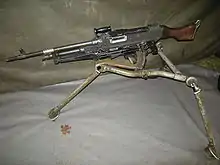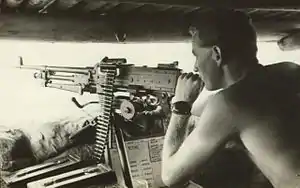FN MAG
The FN MAG is a Belgian 7.62 mm general-purpose machine gun, designed in the early 1950s at Fabrique Nationale (FN) by Ernest Vervier. It has been used by more than 80 countries and it has been made under licence in several countries, including Argentina, Canada (as the C6 GPMG), Egypt, India and the United Kingdom.[6]
| FN MAG | |
|---|---|
 An FN MAG with modern polymer furniture | |
| Type | General-purpose machine gun |
| Place of origin | Belgium |
| Service history | |
| In service | 1958–present |
| Used by | See Users |
| Wars |
|
| Production history | |
| Designer | Ernest Vervier |
| Designed | 1950 |
| Manufacturer | Fabrique Nationale and U.S. Ordnance |
| Produced | 1958–present |
| No. built | 200,000+[4] |
| Variants | See Variants |
| Specifications | |
| Mass | 11.8 kg (26.01 lb) |
| Length | 1,263 mm (49.7 in) |
| Barrel length | 630 mm (24.8 in) |
| Width | 118.7 mm (4.7 in) |
| Height | 263 mm (10.4 in) |
| Cartridge | 7.62×51mm NATO |
| Action | Gas-operated long-stroke piston, open bolt |
| Rate of fire | 650–1,000 rounds/min |
| Muzzle velocity | 840 m/s (2,756 ft/s) |
| Effective firing range | 800 m (875 yd) (bipod) 1,800 m (1,969 yd) (tripod) |
| Maximum firing range | 3,500 m (3,828 yd)[5] |
| Feed system | Non-disintegrating DM1 or disintegrating M13 linked belt |
| Sights | Folding leaf sight with aperture and notch, front blade |
The weapon's name is an abbreviation for Mitrailleuse d'Appui Général,[7] meaning "general support machine gun". The MAG is available in three primary versions: the standard, infantry Model 60-20 machine gun, the Model 60-40 coaxial machine gun for armoured fighting vehicles and the Model 60-30 aircraft variant.
Design details


The MAG Model 60-20 is an automatic, air-cooled, gas-operated machine gun, firing belt-fed 7.62×51mm NATO from an open bolt.
Operating mechanism
The MAG operates via a long-stroke piston system, which utilizes the ignited powder gases generated by firing vented through a port in the barrel to propel a gas piston rod connected to the locking assembly. The barrel breech is locked with a vertically tilting, downward locking lever mechanism that is connected to the bolt carrier through an articulated joint. The locking shoulder and camming surfaces that guide the locking lever are located at the base of the receiver. The MAG uses a series of proven design concepts from other successful firearms, for example the locking mechanism is modeled on that of the Browning M1918 (BAR) automatic rifle, and the feed and trigger mechanisms are from the WWII-era MG 42 universal machine gun.[8]
The MAG fires from an open bolt. Both the spring-powered extractor and ejector are contained in the bolt. After firing, spent cartridge casings are removed through an ejection port located at the base of the receiver (a spring-loaded dust cover of the MG 42 type covers the ejection port). The machine gun has a striker firing mechanism (the bolt carrier acts as the striker as it contains a channel that houses the firing pin, which protrudes out from the surface of the bolt upon firing), an automatic-only trigger assembly and a manual cross-bolt push-button safety, which is located above the pistol grip. With the safety placed in the safe setting, the sear mechanism is disabled. The safety can only be engaged with the weapon cocked.[9]
Features

The weapon feeds from the left side from open-link, metal ammunition belts: either the American disintegrating M13 belt (NATO standard) or the non-disintegrating segmented German DM1 belt, whose 50-round sections can be linked through a cartridge. In order to adapt the weapon to feed from one belt type to the other, several components of the feed mechanism need to be reconfigured since the position of the feed tray's cartridge stop and pawl angles in the top cover are different. The MAG features a pawl-type feeding mechanism that continues to move the feed link during both the rearward and forward cycles of the reciprocating bolt carrier, producing a smooth belt flow. The feeding mechanism's three pawls are actuated by a roller connected to the bolt carrier. The feed channel rail, feed link, both feed slides and the feed tray are chrome plated. The top cover body is an anodized aluminum casting. In the infantry assault role, the weapon can be fitted with a sheet metal container that houses a 50-round belt and is attached to the left side of the receiver.[9]
The quick-change barrel has a slotted flash suppressor. The barrel's chamber and bore are chromium-lined and the barrel has four right-hand grooves with a 305 mm (1:12 in) rifling twist rate. Also attached to the barrel is the front sight base, carry handle and gas block (equipped with an exhaust-type gas regulator valve with three settings).[9] The barrel assembly weighs 3,050 g (6.72 lb) and of the 630 mm (24.80 in) long barrel a portion of 487.5 mm (19.19 in) is rifled.[10] The MAG takes zero shifts between barrel assemblies into account by making the front sight of the assemblies adjustable with the help of tools.
The machine gun is fitted with a folding bipod (attached to the end of the gas cylinder) that can be adjusted for height. For carrying or use as a forearm, the aluminum legs can be folded back and secured in slots under the receiver by hooks and a spring-loaded catch. When firing from the hip, the bipod legs remain extended and the left leg is gripped for support. The bipod can be removed from the gas cylinder by tapping-out a roll pin in the gas cylinder head until it is flush and the bipod can be rotated enough to clear the gas cylinder's retaining lugs.[9]
The MAG is also equipped with a fixed wooden stock, pistol grip, carrying handle and iron sights that consist of a forward blade (adjustable mechanically for both windage and elevation) and a folding leaf rear sight with an aperture in the down position for firing distances from 200 to 800 m (219 to 875 yd) in 100 m (109 yd) increments and an open U-notch for ranges from 800 to 1,800 m (875 to 1,969 yd) graduated every 100 m (109 yd). The rear sight is hinged to a base with protective ears that is integral with the receiver's upper forging. The iron sight line has a 848 mm (33.4 in) sight radius.
The MAG's receiver is constructed from sheet metal stampings reinforced by steel plates and rivets. The front is reinforced to accept the barrel nut and gas cylinder which are permanently mounted. Guide rails that support the bolt assembly and piston extension during their reciprocating movement are riveted to the side plates. The bolt's guide rails are shaped downward to drive the locking lever into engagement with the locking shoulder, which is also riveted to the side plates. The rear of the receiver has been reinforced and slotted to accept the butt-stock.[9]
In the static machine gun role, the weapon is mounted on a tripod that offers a higher degree of accuracy and control than the bipod, for example the FN 360° tripod, which features an elevation adjustment mechanism that enables the weapon's bore axis to be maintained from 300 mm (11.8 in) to 600 mm (23.6 in), has a 30° to +15° elevation change and a 360° traverse range. When used in the anti aircraft role, the machine gun can increase the cyclic rate of fire from 650 up to 1,000 rpm by regulating a user adjustable gas valve.
Variants
Variants of the FN MAG were manufactured by at least ten companies: FN Herstal, Fabricaciones Militares, Changfeng Machinery, Indian Ordnance Factories, the Ordnance Development and Engineering Company of Singapore, Canadian Arsenals Limited, the Royal Small Arms Factory, Heckler and Koch, Manroy Engineering, Yunnan Xiyi Industry Company Limited, and Egypt's Maadi Company for Engineering Industries.[11][12][13][14][15]
FN production variants


| Designation | Description |
|---|---|
| MAG 60.20 | Standard infantry version with pistol grip, fixed buttstock and bipod; Many subvariants including the T3 (L7A1) and T6 (L7A2) |
| MAG 60.30 | Fixed aircraft version, firing from a solenoid trigger; Capable, at least in some subvariants, of left and right hand feeding |
| MAG 60.40 | Coaxial version for armoured fighting vehicles; Many subvariants including the T3 (M240) |
| MAG 10.10 | Jungle version with shorter barrel and buttstock. |
The vehicle-mounted variant of the MAG lacks a stock, bipod, carry handle, pistol grip, ejection port dust cover and a mount for optical sights. It does, however, have a new closed-type gas regulator. Depending on the weapon's employment, the machine gun can also be fitted with an extended charging handle linkage, standard trigger group (with a pistol grip), or a specialized trigger assembly with an electrically fired trigger.
The pintle-mounted aircraft model is fed from either the right- or left-hand side exclusively with the M13 belt. Thus configured, weapons typically lack standard iron sights and are equipped with electrically powered triggers.
British versions
| Designation | Description |
|---|---|
| L7A1 | 7.62×51mm NATO FN MAG 60.20 T3 machine gun. |
| L7A2 | L7A1 variant; FN MAG 60.20 T6; Improved feed mechanism and provision for 50 round belt-box. |
| L8A1 | L7A1 variant; For mounting inside AFVs. No buttstock. Barrel fitted with fume extractor. Solenoid-triggered, but with folding pistol grip for emergency use. |
| L8A2 | L8A1 variant; improved feed mechanism. |
| L19A1 | L7A1 variant; extra-heavy barrel. |
| L20A1 | L7A1 variant; for remote firing in gun pods and external mountings. |
| L20A2 | L20A1 variant; improved feed mechanism. |
| L37A1 | L8A1 variant; L8A1 breech & L7 barrel for mounting on AFVs. Conventional pistol grip and trigger, plus kit allowing dismounted use. |
| L37A2 | L37A1 variant; L8A2 based. As above. |
| L43A1 | L7A1 variant; for use as a ranging gun on the Scorpion light tank |
| L44A1 | L20A1 variant; for Royal Navy |
| L112A1 | L7A2 variant; for mounting on Lynx Helicopter |
.jpg.webp)
The L7 general-purpose machine gun is used by the British Army.[16] The L7 and the related L8 are license-built derivatives of the MAG. The official British Army designation for the current version is the L7A2 GPMG (General Purpose Machine Gun).
The L7 was adopted by the British forces as a replacement for the long-serving Vickers machine gun (in the medium role) and the Bren (in the light assault role), following trials in 1957. Built under license originally by Royal Small Arms Factory, Enfield Lock and currently by Manroy Engineering,[17] it serves in the British Army, the Royal Marines and other services. There have been two main variants, the L7A1 and L7A2, developed for infantry use, with the L7A2 having superseded the earlier variant. Several other variants have been developed, notably the L8 (produced in the L8A1 and L8A2 versions), modified for mounting inside armoured vehicles (the L37 variant was developed for mounting on armoured vehicles). Although intended to replace the Bren entirely, that light machine gun (re-chambered for 7.62x51mm NATO and re-titled as the L4) continued in use in jungle terrain (especially in the Far East), where there was no requirement for the medium machine gun role, and with secondary units, until the adoption of the L86A1 Light Support Weapon (LSW). The LSW was intended to replace both the L7 and the L4 in the light machine gun role, but dissatisfaction with the L86's sustained fire capabilities and reliability resulted in combat units continuing to utilize the L7 whenever possible (although neither it, nor its 7.62×51mm NATO ammunition was supposed to be issued to infantry platoons). The British Army and Royal Marines were issued with the L110A2 (FN Minimi Para) to replace the LSW as the light section support or fire support weapon. This uses the same NATO-standard 5.56×45mm ammunition as the L85 assault rifle. However a review of requirements led to the withdrawal of both the L110A2 LMG and L86A2 LSW from service in 2018, with the 7.62 mm L7A2 resuming its place in the British Army infantry section. Other variants continue to be used in mounted roles on many British military vehicles, naval vessels and aircraft.
In 1961, the Royal Small Arms Factory, Enfield (now BAE Systems) in the United Kingdom, undertook licence production of the MAG in the following versions: L7A2, L8A2, L37A2, L20A1 and the L43A1. These models all use the M13 ammunition belt.
The L7A2, general-purpose machine gun, replaced the L7A1 in service with the British Army. Compared to the MAG Model 60-20, it features, among other minor changes, a 10-position gas regulator valve, a polymer butt-stock and a bracket, used to mount optical day- and night-vision sights, mounted to the left side of the receiver. In a stationary (defensive) role, the L7A2 can be mounted on the L4A1 tripod in conjunction with a C2A2 Support Weapons Sight or the sight unit used on the FGM-148 Javelin anti-tank missile system. Fired by a two-man team who are grouped in a specialist Machine Gun Platoon the L7A2 in conjunction with a C2A2 Support Weapons Sight can provide battalion-level direct support fire at ranges up to 1,800 m (1,969 yd) and indirect map and range table predicted support/harassment fire out to 2,500 m (2,734 yd).
The L8A2 coaxial tank machine gun (replaced the L8A1) has a different gas valve switch (closed, single-position) when compared to the analogous Model 60-40, a different flash hider and a modified cocking handle. The weapon also has a trigger group that accepts electrical input and a lever in the feed tray that enables the belt to be removed without lifting the feed tray cover.
Another tank machine gun is the L37A2 (succeeded the L37A1) designed to be mounted on tank turrets, in the commander's position, on wheeled armoured vehicles and on armored personnel carriers. It differs from the L8A2 primarily in its trigger, which was adapted from the L7A2 GPMG. The machine gun can be used in the ground role for self-defense, by dismounted vehicle crew members, the egress kit consists of an L7A2 barrel, bipod and buttstock.
The L20A1 aircraft machine gun was based on the L8A2, from which it differs by having an electrical trigger and a slotted flash suppressor. The L20A1 can be converted to right-hand feed by changing several components in the feed mechanism.
The L43A1, also developed from the L8A2, is a coaxially mounted tank machine gun used to sight-in the vehicle's main gun by firing ballistically-matched tracer ammunition at the target to confirm the trajectory visually. The weapon's barrel, fitted with a flash hider, has a reinforced and heavier structure that increases the weapon's accuracy especially during sustained fire.'
China
An unlicensed version is made for export by Norinco and made by Changfeng Machinery Co., Ltd as the CQ, 7.62 × 51 (Copy Version) (Now renamed CS/LM1 as of 2006)[18] with an adjustable butt.[19][13] The weapon was officially produced in 2006[20] and it was showcased in various foreign military expo conventions.[18]
The XY, 7.62 × 51 is a true copy of the FN MAG made with a wooden stock by Yunnan Xiyi Industry Company Limited.[12][14]
German versions
German arms manufacturer, Heckler & Koch, attempted to make their own variant of the FN MAG; it was designated the HK 221. This version was meant to compete in the machine guns trials held by the German and French military between 2007-2008; the trials concluded with the French military continuing to use the original FN MAG while the German military chose the HK121.[21]
Indonesian versions

Indonesian arms manufacturer PT. Pindad license produced FN MAG in 2003 as SM2.[22][23] SM2 V1 variant comes with integrated bipod, with a total length of 1275 mm and a weight of 11.6 kg (including stock and bipod). The second variant is called SM2 V2 which is modified as a coaxial gun. The stock is removed by changing the trigger mechanism to the rear of the weapon as in the M2 Browning. This variant has a higher rate of fire of 700-1200 rpm. It is shorter at only 1070 mm in length with a weight (plus coaxial) of 12 kg.[22]
Swedish Army versions
All versions are licence-manufactured by FFV-Carl Gustaf. The Swedish abbreviation for kulspruta (machine gun, lit. "bullet sprayer") is Ksp. Strv is the abbreviation of Stridsvagn (battle tank).

Kulspruta 58: Ksp 58, adapted in 1958 using the 6.5×55mm rifle cartridge which at that time was the standard cartridge in the Swedish Army.
Kulspruta 58 B: In the early 1970s, the weapon was modified with a new gas regulator and at the same time the barrels were replaced to the new standard 7.62×51mm NATO, same as used by the Ak 4. Ksp 58 replaced the considerably heavier Ksp m/42B in the infantry units. It can be fed with non-disintegrating DM1 or disintegrating M13 linked ammunition belts.
Kulspruta 58 C: On Combat Vehicle 90, this version replaced the previously used Ksp m/39 in the third quarter of 2004.
Kulspruta 58 Strv: stripped variant mainly used for fixed mounting in tanks. Phased out along with Stridsvagn 103.
Kulspruta 58 D: Reserved designation for the renovated and modified Ksp 58B. The trial version is referred to as 'Ksp 58 DF', where the 'F' stands for 'Försök' (Experimental). Some of the modifications:[24]
- A MIL-STD 1913 Picatinny rail system added. Half of the weapons feature an adjustable rail - the others a fixed.
- Red dot sight (Aimpoint CompCS).
- The carrying handle is shortened to half its original length. This was necessary in order to fit an extended rail for sight systems.
- Cbuttstock butt stock or folding stock.
- 100 mm shorter barrel.
- Better and shorter flash hider to reduce the length of the weapon and to produce a smaller muzzle flash, which means less disruption to the user's night vision.
- Fluted barrel in order to reduce the weight and better dissipate the heat of the barrel.
- Gas regulator has only 4 settings (instead of 8). The last position is painted red and is intended for emergency use.
- Larger 100-round ammunition pouches replaced 50-round pouches.
- New ammunition cases.
- New equipment bags.
- Bi-pod is painted green.
- There is a sheet for protection / one side green other side white / summer & winter camouflage.
- The weight of the MG is the same, but the entire system is 3 kg (6.5 lbs) lighter.
US Army versions



On January 14, 1977, the US Army awarded a contract to FN Herstal for the delivery of a modernized Model 60-40 variant tank machine gun designated the M240. Initially, the firearms were produced in Belgium. Currently they are manufactured in the US by FN's US wholly owned subsidiary FNMI (FN Manufacturing Inc.) located in Columbia, South Carolina, and by U.S. Ordnance in McCarran, Nevada.
The M240 is built in several versions:
- M240 standard coaxial machine gun used in US armored vehicles. It is used in the M60 series of tanks (where it replaced the M73/M219 7.62 mm machine guns) and the M1 Abrams family. It has an electrically operated trigger and a reloading lever. Compared to the MAG Model 60-40, the M240 has a different flash hider and gas valve.
- M240B is a modernized derivative of the M240G, which features a perforated hand-guard and heat shroud, a MIL-STD-1913 rail integral with the receiver top cover, which enables the use of optical day and night sights, a new synthetic stock and a new ammunition container. It was selected to be the U.S. Army's new medium machine gun on December 1, 1995, replacing the M60 machine gun - it defeated the M60E4 during trials. M240Bs are also replacing M240Gs in USMC service. The M240B weighs 12.5 kg (28 lb) and has a length of 1,245 mm (49.0 in). The rate of fire is 650–750 rounds/min.
- M240C with a right-hand feed system. It is used in the M2 and M3 Bradley series of infantry fighting vehicles as a coaxial gun to the main armament.
- M240D an upgrade of the M240E1 and is optimized for use in military helicopters in a pintle-mounted configuration. The M240D is also supplied with an egress kit for dismounted use.
- M240E1 installed since 1987 on LAV-series wheeled armored fighting vehicles, has a spade-type grip with an integral trigger and cocking mechanism.
- M240G introduced into service with the United States Marine Corps and the 75th Ranger Regiment in the mid 1990s in place of the M60E3. The M240G is used on the M122A1 tripod for stationary use, and is also used in vehicular and aircraft mounts. It weighs 10.99 kg (24.2 lb),[8] has an overall length of 1,245 mm (49.0 in) and a rate of fire of 650–950 rounds/min.
- M240H an improved version of the M240D. The M240H features a rail-equipped feed cover, an improved flash suppressor and has been configured so it can be more quickly converted to infantry standard using an Egress Kit. The M240H is 41.2 in (1,050 mm) long, has a 23.6 in (600 mm) barrel, and has an empty weight of 26.3 lb (11.9 kg).
- M240L is a development of the M240B reduced in weight by 5.5 pounds (2.5 kg). The weight savings on the M240L are achieved by incorporating titanium and by using alternative fabricating methods for major components. A short barrel and collapsible stock are available.
Turkey
MKEK has announced that a licensed version of MAG called PMT-76 or MFY-71 will be made under the National Machinegun Project (Turkish: Milli Makineli Tüfek Projesi - MMT).[25] 12 prototypes of PMT-76 were tested in 2017 and order of undisclosed number was put.[26] Current specifications are:[27]
- Barrel: 547mm
- Rate of fire: 600-900 r/m
- Range: 800m
- Mass: 8kg[28]
Users
 Argentina: The MAG is in use in the Argentine Army as the 7,62 Ametralladora Tipo 60-20 MAG[29] after being purchased in the 1960s.[30] The MAG saw action during the Falklands War. Argentine MAGs were license-manufactured by the state-owned Dirección General de Fabricaciones Militares (DGFM) arsenal.[31][32]
Argentina: The MAG is in use in the Argentine Army as the 7,62 Ametralladora Tipo 60-20 MAG[29] after being purchased in the 1960s.[30] The MAG saw action during the Falklands War. Argentine MAGs were license-manufactured by the state-owned Dirección General de Fabricaciones Militares (DGFM) arsenal.[31][32]

.svg.png.webp) Australia: The MAG is the standard GPMG of the Australian Defence Force, in particular the Australian Army, where it is known as the MAG 58.[33] It is also used by the Australian Customs and Border Protection Service.[34]
Australia: The MAG is the standard GPMG of the Australian Defence Force, in particular the Australian Army, where it is known as the MAG 58.[33] It is also used by the Australian Customs and Border Protection Service.[34] Austria: The MAG is used by the Austrian Army as the 7,62 mm MG FNMAG/Pz and is used in the Schützenpanzer Ulan and the Leopard 2A4.[5][35] It's also used as the armament of the new S-70A-42 Black Hawk helicopters.[5]
Austria: The MAG is used by the Austrian Army as the 7,62 mm MG FNMAG/Pz and is used in the Schützenpanzer Ulan and the Leopard 2A4.[5][35] It's also used as the armament of the new S-70A-42 Black Hawk helicopters.[5] Bangladesh[36]
Bangladesh[36] Bahrain[36]
Bahrain[36] Barbados[36]
Barbados[36].svg.png.webp) Belgium: Designated MAG M2 and MAG M3 for the coax version.[36][37]
Belgium: Designated MAG M2 and MAG M3 for the coax version.[36][37] Belize[36]
Belize[36] Bolivia[36]
Bolivia[36] Botswana[36]
Botswana[36] Brazil: Standard support weapon of the Brazilian Army, known as the M971.[38] Used by the Coordenadoria de Recursos Especiais (from the Civil Police of Rio de Janeiro), the Federal Police[39] and the Brazilian Marine Corps (Mod B60-20).[40]
Brazil: Standard support weapon of the Brazilian Army, known as the M971.[38] Used by the Coordenadoria de Recursos Especiais (from the Civil Police of Rio de Janeiro), the Federal Police[39] and the Brazilian Marine Corps (Mod B60-20).[40] Brunei[36]
Brunei[36] Burkina Faso[36]
Burkina Faso[36] Burundi[36]
Burundi[36] Cameroon[36]
Cameroon[36]


.svg.png.webp) Canada: The C6 was first used in Canada for use as a coaxial MG in the Leopard C1 main battle tank. Since then, it has been used in the Canadian Forces with the designation the C6 GPMG,[41] it is used primarily as a platoon level support weapon.[42] One C6 machine gun is assigned to each Rifle platoon. The C6 GPMG is also mounted on a variety of vehicles, including the G-Wagon LUVW, LAV III, Coyote, Leopard C2, and CH-146 Griffon helicopter. In these vehicles, the C6 GPMGs are co-axially and pintle-mounted and used to provide fire support to the infantry or for local defence of the vehicle itself. Canada adopted a new version of C6 called C6A1 FLEX.
Canada: The C6 was first used in Canada for use as a coaxial MG in the Leopard C1 main battle tank. Since then, it has been used in the Canadian Forces with the designation the C6 GPMG,[41] it is used primarily as a platoon level support weapon.[42] One C6 machine gun is assigned to each Rifle platoon. The C6 GPMG is also mounted on a variety of vehicles, including the G-Wagon LUVW, LAV III, Coyote, Leopard C2, and CH-146 Griffon helicopter. In these vehicles, the C6 GPMGs are co-axially and pintle-mounted and used to provide fire support to the infantry or for local defence of the vehicle itself. Canada adopted a new version of C6 called C6A1 FLEX. Central African Republic[43]
Central African Republic[43] Chad[36]
Chad[36] Chile[44]
Chile[44] China:Used by Special Force, designated as CS/LM1.[45]
China:Used by Special Force, designated as CS/LM1.[45] Colombia[36]
Colombia[36] Democratic Republic of Congo[36]
Democratic Republic of Congo[36]
 Denmark: Used as armament in EH101.[47]
Denmark: Used as armament in EH101.[47] Djibouti[36]
Djibouti[36] Dominican Republic[36]
Dominican Republic[36] Ecuador[36]
Ecuador[36] El Salvador[48]
El Salvador[48] Egypt: Made under license by the Maadi Company for Engineering Industries.[6][31][49] Egyptian-made MAGs known as Helwan 920.[50]
Egypt: Made under license by the Maadi Company for Engineering Industries.[6][31][49] Egyptian-made MAGs known as Helwan 920.[50] Estonia: The Swedish-made version known as the Ksp 58B has been adopted as the standard MG.[51]
Estonia: The Swedish-made version known as the Ksp 58B has been adopted as the standard MG.[51] Finland:100 machine guns came from Holland with Leopard 2A6 MBT:s in 2015-2019
Finland:100 machine guns came from Holland with Leopard 2A6 MBT:s in 2015-2019 France: Selected in 2010. 500 machine guns were purchased in 2011, and an additional 10,000 machine guns will eventually be supplied.[52]
France: Selected in 2010. 500 machine guns were purchased in 2011, and an additional 10,000 machine guns will eventually be supplied.[52] Gabon[36]
Gabon[36] Gambia[36]
Gambia[36] Georgia: M240L variant in use.[53]
Georgia: M240L variant in use.[53] Ghana[36]
Ghana[36] Guatemala[36]
Guatemala[36] Greece: Used by the Hellenic Army.
Greece: Used by the Hellenic Army. Haiti[36]
Haiti[36] Honduras[36]
Honduras[36] India: Manufactured by the Ordnance Factories Board under license.[6]
India: Manufactured by the Ordnance Factories Board under license.[6] Indonesia: Standard general-purpose machine gun of Indonesian Armed Forces. Also used by Komando Pasukan Katak (Kopaska) tactical diver group and Komando Pasukan Khusus (Kopassus) special forces group.[54] FN MAGs made under license as the SPM2 GPMG by PT Pindad.[55]
Indonesia: Standard general-purpose machine gun of Indonesian Armed Forces. Also used by Komando Pasukan Katak (Kopaska) tactical diver group and Komando Pasukan Khusus (Kopassus) special forces group.[54] FN MAGs made under license as the SPM2 GPMG by PT Pindad.[55] Iraq[56]
Iraq[56] Ireland: Used by the Irish Defence Forces.[57]
Ireland: Used by the Irish Defence Forces.[57]

 Israel: Used by the Israel Defense Forces alongside IMI Negev and Negev NG7.[58]
Israel: Used by the Israel Defense Forces alongside IMI Negev and Negev NG7.[58] Jamaica: Battalion-level fire support weapon of the Jamaica Defence Force.[59]
Jamaica: Battalion-level fire support weapon of the Jamaica Defence Force.[59] Jordan[60][61]
Jordan[60][61] Katanga[62]
Katanga[62] Kuwait[48][63]
Kuwait[48][63] Latvia: The Swedish-made version known as the Ksp 58B has been adopted by the Latvian National Guard as the standard MG.[64]
Latvia: The Swedish-made version known as the Ksp 58B has been adopted by the Latvian National Guard as the standard MG.[64] Lebanon: Adopted as standard MG by the Lebanese Armed Forces.
Lebanon: Adopted as standard MG by the Lebanese Armed Forces. Lesotho[65]
Lesotho[65] Libya[66]
Libya[66]

 Lithuania: Lithuanian Armed Forces.[67]
Lithuania: Lithuanian Armed Forces.[67] Luxembourg[68]
Luxembourg[68] Malaysia[69]
Malaysia[69] Mexico[44]
Mexico[44] Monaco: Compagnie des Carabiniers du Prince.[70]
Monaco: Compagnie des Carabiniers du Prince.[70] Morocco: MAG-60-20 Infanterie T1.[71]
Morocco: MAG-60-20 Infanterie T1.[71] Netherlands: Used by the Royal Navy, Marine Corps, Royal Air Force and Royal Army.[72] The designation used by the Marine Corps is Mitrailleur van 7,62 mm NATO MAG FN[73] whereas the Army designates the weapon as Mitrailleur 7.62 mm MAG.[74] These legacy MAGs were replaced by newer models, featuring rails and polymer furniture.[75]
Netherlands: Used by the Royal Navy, Marine Corps, Royal Air Force and Royal Army.[72] The designation used by the Marine Corps is Mitrailleur van 7,62 mm NATO MAG FN[73] whereas the Army designates the weapon as Mitrailleur 7.62 mm MAG.[74] These legacy MAGs were replaced by newer models, featuring rails and polymer furniture.[75] New Zealand: The New Zealand Defence Force originally purchased the British-made L7A2 version of the MAG in 1976. These are now being replaced by several versions of the Belgian-made MAG-58, which was originally introduced into service as part of the introduction of the NZLAV. The FN-made MAGs are now used in the infantry light machine gun (LMG) role as a flexible mounted machine gun on the LOV and UH-1H and as a heavy sustained fire machine gun.[76]
New Zealand: The New Zealand Defence Force originally purchased the British-made L7A2 version of the MAG in 1976. These are now being replaced by several versions of the Belgian-made MAG-58, which was originally introduced into service as part of the introduction of the NZLAV. The FN-made MAGs are now used in the infantry light machine gun (LMG) role as a flexible mounted machine gun on the LOV and UH-1H and as a heavy sustained fire machine gun.[76] Nicaragua: Adopted by the Guardia Nacional de Nicaragua in the 1970s as standard MG.
Nicaragua: Adopted by the Guardia Nacional de Nicaragua in the 1970s as standard MG. Niger[66]
Niger[66] Nigeria[44]
Nigeria[44] Norway[77] On Leopard 2A4 MBTs bought from the Netherlands. Supposed to replace the Rheinmetall MG3 in Norwegian service.
Norway[77] On Leopard 2A4 MBTs bought from the Netherlands. Supposed to replace the Rheinmetall MG3 in Norwegian service. Pakistan[78]
Pakistan[78] Panama[44]
Panama[44] Papua New Guinea: Likely acquired from Australian stocks.[79]
Papua New Guinea: Likely acquired from Australian stocks.[79] Portugal: Used by Portuguese Army on Pandur II IFV and Leopard 2A6.[80][81]
Portugal: Used by Portuguese Army on Pandur II IFV and Leopard 2A6.[80][81].svg.png.webp) Rhodesia[82][83]
Rhodesia[82][83].svg.png.webp) Rwanda[46]
Rwanda[46] Saudi Arabia[84]
Saudi Arabia[84] Sierra Leone: Sierra Leone Army used ex-British L7A2 GPMG. Some were captured by rebels.[85]
Sierra Leone: Sierra Leone Army used ex-British L7A2 GPMG. Some were captured by rebels.[85] Singapore: In use by Singapore Armed Forces and Police Coast Guard. Licensed production carried out by Ordnance Development and Engineering Company of Singapore, now integrated to ST Engineering. Two versions produced, one infantry assault variant fitted with a bi-pod, the other co-axial model for armored vehicle or vehicle mountings. One MAG is issued to each rifle platoon. It is always referred to as GPMG or simply MG.[31] ST Engineering manufacture it as the 7.62 General Purpose Machine Gun.[86]
Singapore: In use by Singapore Armed Forces and Police Coast Guard. Licensed production carried out by Ordnance Development and Engineering Company of Singapore, now integrated to ST Engineering. Two versions produced, one infantry assault variant fitted with a bi-pod, the other co-axial model for armored vehicle or vehicle mountings. One MAG is issued to each rifle platoon. It is always referred to as GPMG or simply MG.[31] ST Engineering manufacture it as the 7.62 General Purpose Machine Gun.[86] Slovenia[87]
Slovenia[87] South Africa[36]
South Africa[36] Spain: Used by the Spanish Army Airmobile Force.[88]
Spain: Used by the Spanish Army Airmobile Force.[88] Sri Lanka[89]
Sri Lanka[89] Sudan[66]
Sudan[66] Sweden: Used by the Swedish Armed Forces, license made in Sweden and designated as the Ksp 58 (short for "Kulspruta", Swedish for "Machine gun" of model 1958).[90][91][92]
Sweden: Used by the Swedish Armed Forces, license made in Sweden and designated as the Ksp 58 (short for "Kulspruta", Swedish for "Machine gun" of model 1958).[90][91][92] Taiwan: produced locally as T74 GPMG.
Taiwan: produced locally as T74 GPMG. Thailand[93]
Thailand[93] Tunisia[66]
Tunisia[66] Turkey[94][95]
Turkey[94][95] United Kingdom[6]
United Kingdom[6] United States: Used by the U.S. Military, designated as the M240.[93]
United States: Used by the U.S. Military, designated as the M240.[93] Uruguay[44]
Uruguay[44] Venezuela[44]
Venezuela[44] Vietnam: Limited use
Vietnam: Limited use Zimbabwe[96][97]
Zimbabwe[96][97]
See also
- FN Minimi—FN MAG scaled down to 5.56 NATO
- Mk 48 machine gun—FN Minimi in 7.62×51mm NATO for United States Special Operations Command (USSOCOM)
- IWI Negev and Negev-NG7—Israel weapon
- Type 67 machine gun—Chinese weapon
- Sumitomo NTK-62—an outwardly similar Japanese weapon
- Heckler & Koch HK121—A German derivative intended to replace the well-proven Rheinmetall MG 3
- PKM and PKP Pecheneg machine gun—Russian squad automatic weapons
- Vektor SS-77—A South African weapon designed as replacement for the FN-MAG
References
Citations
- Jowett, Philip (2016). Modern African Wars (5): The Nigerian-Biafran War 1967-70. Oxford: Osprey Publishing Press. p. 20. ISBN 978-1472816092.
- Small Arms Survey (2007). "Armed Violence in Burundi: Conflict and Post-Conflict Bujumbura" (PDF). The Small Arms Survey 2007: Guns and the City. Cambridge University Press. p. 204. ISBN 978-0-521-88039-8. Archived from the original on 2018-08-27. Retrieved 2018-08-29.
- الفيلق الثاني الفرقة الثانية (12 June 2017). "فرقة الحمزة بعد صد عدة محاولات لمليشا النظام على قرية التفريعة" – via YouTube.
- "FN MAG® Standard - FN Herstal". Archived from the original on 2013-10-24. Retrieved 2014-01-09.
- 7,62 mm Maschinengewehr FN MAG 58. Archived 2008-06-05 at the Wayback Machine Retrieved on April 2, 2008.
- Hogg, Ian (2002). Jane's Guns Recognition Guide. Jane's Information Group. ISBN 0-00-712760-X.
- World Gun's FN MAG page. Archived 2007-02-06 at the Wayback Machine Retrieved on November 21, 2008.
- "Modern Firearms - FN MAG". World.guns.ru. 2010-10-27. Archived from the original on 2012-06-04. Retrieved 2012-07-30.
- Kokalis, Peter G. (March 1985). "Belgium's MAGnificent MG". Soldier of Fortune Magazine. Archived from the original on 2014-05-13. Retrieved 2014-05-11.
- FN MAG Technical data
- "Multiplying the Sources: Licensed and Unlicensed Military Production" (PDF). Geneva: Small Arms Survey. 2007. Archived from the original (PDF) on 23 December 2016. Retrieved 21 September 2016.
- Popenker, Maxim & Williams, Anthony G., page 41.
- "图文:CQ7.62毫米通用机枪压入弹链状态_新浪军事_新浪网". jczs.news.sina.com.cn. Archived from the original on 2016-11-04. Retrieved 2016-11-03.
- "图文:国产外贸型XY 7.62MM通用机枪_新浪军事_新浪网". jczs.news.sina.com.cn. Archived from the original on 2016-03-04. Retrieved 2016-11-03.
- https://www.thefirearmblog.com/blog/2009/10/21/hk-redesigned-l7a2-and-the-me-redesigned-7-62-gpmg/. Missing or empty
|title=(help) - "General Purpose Machine Gun". Army.mod.uk. Archived from the original on 2013-01-10. Retrieved 2011-06-24.
- "The General Purpose Machine Gun". www.manroy.co.uk. Archived from the original on 16 October 2007. Retrieved 10 November 2018.
- "CQ通用机枪与MAG机枪性能基本相同_新浪图集_新浪网". 4 November 2016. Archived from the original on 4 November 2016.
- "CQ通用机枪与MAG机枪性能基本相同_新浪图集_新浪网". slide.mil.news.sina.com.cn. Archived from the original on 2016-03-04. Retrieved 2016-11-03.
- "图文:国产CQ7.62毫米通用机枪无枪架状态_新浪军事_新浪网". jczs.news.sina.com.cn. Archived from the original on 2014-08-09. Retrieved 2016-11-03.
- "HK 221". world.guns.ru. 2011-08-12. Archived from the original on 2018-07-17. Retrieved 2018-10-17.
- KKIP (2020-06-09). "Mengenal Industri Pertahanan dalam Negeri PT. PINDAD #2". KKIP Komite Kebijakan Industri Pertahanan. Retrieved 2020-09-16.
- "Industri Strategis - Senapan Mesin SM-2/SPM-2, Produk Unggulan Pindad". theglobal-review.com. Retrieved 2020-09-16.
- "Göta Vapenhistoriska Sällskapet". March 31, 2010. Archived from the original on April 18, 2012. Retrieved May 31, 2010.
- "MKEK's 7.62mm PKM and MAG designs, Production Ready? -". 13 October 2017. Archived from the original on 23 October 2017. Retrieved 22 October 2017.
- https://www.trthaber.com/haber/turkiye/yerli-makineli-tufek-pmt-76-icin-geri-sayim-basladi-441625.html
- https://www.bik.gov.tr/guvenlik-guclerine-yerli-makineli-tufek-pmt-76/
- https://www.sabah.com.tr/galeri/aktuel/turk-ordusuna-3-yeni-nesil-milli-silah/9
- MAG 7.62 being used in military training exercises in Misiones, Argentina: http://www.infobae.com/adjuntos/imagenes/99/0079971B.jpg Archived 2007-03-21 at the Wayback Machine
- Smith, Joseph E. (1969). Small Arms of the World (11 ed.). Harrisburg, Pennsylvania: The Stackpole Company. p. 194.
- Multiplying the Sources. Archived 2010-07-05 at the Wayback Machine Retrieved on October 5, 2008.
- European arms exports to Latin America - An inventory. Archived 2008-12-09 at the Wayback Machine Retrieved on August 15, 2008.
- "MAG58 - Army Internet". www.defence.gov.au. Archived from the original on 12 October 2009. Retrieved 10 November 2018.
- "House Hansard 14 June 2005, p 209". Parlinfo.aph.gov.au. Archived from the original on 16 October 2012. Retrieved 2011-06-24.
- BMLV - Presseabteilung - Referat Internet. "Österreichs Bundesheer - Waffen und Gerät - Turmdachmaschinengewehr MAG (für Leopard A4)" (in Dutch). Bmlv.gv.at. Archived from the original on 2011-09-27. Retrieved 2011-06-24.
- Jones, Richard (2009). Jane's Infantry Weapons 2009-2010. Jane's Information Group. pp. 896–898. ISBN 978-0-7106-2869-5.
- "Landcomponent Onderwerp Bewapening MAG 7.62 mm" (in Dutch). Mil.be. Archived from the original on 2012-03-09. Retrieved 2011-06-24.
- "Mtr M9 M972 (Beretta/Taurus)". Exército Brasileiro. Archived from the original on 11 October 2007. Retrieved 10 November 2018.
- "Polícia Civil do Rio utiliza arma proibida pelo exército". Tribuna do Norte. 2013-05-14. Archived from the original on 2016-04-16.
- "Armamento Leve" [Light Weaponry]. Comando do Material de Fuzileiros Navais. Archived from the original on 2016-08-27. Retrieved 2017-01-10.
- "TC6 GENERAL PURPOSE MACHINE-GUN". Army.forces.gc.ca. 2009-07-20. Archived from the original on 2011-06-10. Retrieved 2011-06-24.
- "Canadian Small Arms – Automatic Rifles – A Visual Guide". Canadian American Strategic Review. Archived from the original on 2011-07-06. Retrieved 2008-04-02.
- Letter dated 26 June 2014 from the Panel of Experts on the Central African Republic established pursuant to Security Council resolution 2127 (2013) addressed to the President of the Security Council (PDF). 1 July 2014. p. 81. Archived (PDF) from the original on 29 March 2017. Retrieved 30 January 2019.
- Gander, Terry J.; Hogg, Ian V. Jane's Infantry Weapons 1995/1996. Jane's Information Group; 21 edition (May 1995). ISBN 978-0-7106-1241-0.
- https://www.militaryfactory.com/special-forces/south-china-sword-special-forces-weapons.asp Archived 2019-01-11 at the Wayback Machine
- Small Arms Survey (2015). "Waning Cohesion: The Rise and Fall of the FDLR–FOCA" (PDF). Small Arms Survey 2015: weapons and the world (PDF). Cambridge University Press. p. 201. Archived (PDF) from the original on 2018-01-28. Retrieved 2018-08-29.
- "Danish Airshow 2016". danishairshow.dk/. Archived from the original on 9 March 2016. Retrieved 10 November 2018.
- Norman Friedman (January 1997). The Naval Institute Guide to World Naval Weapons Systems, 1997-1998. Naval Institute Press. pp. 460–. ISBN 978-1-55750-268-1. Archived from the original on 2014-07-07. Retrieved 2016-03-06.
- "G3 Defence Magazine August 2010". En.calameo.com. 2010-08-04. Archived from the original on 2012-07-09. Retrieved 2011-06-24.
- "IDEX ABU 2017". Small Arms Defense Journal. Archived from the original on 2018-01-23. Retrieved 2018-09-30.
- "Eesti Kaitsevägi - Tehnika - Kuulipilduja KSP-58" (in Estonian). Mil.ee. Archived from the original on 2011-10-21. Retrieved 2011-06-24.
- "FN Herstal wins French Competition for 7.62 Machine Guns". Fnherstal.com. January 19, 2011. Archived from the original on 4 August 2016. Retrieved 2011-06-24.
- "NATO-standard weapons to replace Soviet arms in Georgian armament". Archived from the original on 2018-05-23. Retrieved 2017-05-31.
- "Kopassus & Kopaska - Specijalne Postrojbe Republike Indonezije" (in Croatian). Hrvatski Vojnik Magazine. Archived from the original on 2010-08-22. Retrieved 2010-06-12.
- "Un repaso a las armas ligeras de Pindad" (in Spanish). ARMAS. Archived from the original on 2013-04-02. Retrieved 2010-07-05.
- Jones, Richard (2009). Jane's Infantry Weapons 2009-2010. Jane's Information Group. p. 359. ISBN 978-0-7106-2869-5.
- Army Weapons - General Purpose Machine Gun. Archived 2008-08-13 at the Wayback Machine Retrieved on April 2, 2008.
- "Modern Firearms: Negev machine gun". World.guns.ru. 2011-01-24. Archived from the original on 2012-05-27. Retrieved 2011-06-24.
- ncoicinnet. "Equipment - Weapons". Jdfmil.org. Archived from the original on 2012-04-19. Retrieved 2011-06-24.
- "Special Operations Report -Spotlight Jordan" (PDF). Archived (PDF) from the original on 2012-05-18. Retrieved 2013-05-16.
- Jones, Richard D. Jane's Infantry Weapons 2009/2010. Jane's Information Group; 35 edition (January 27, 2009). ISBN 978-0-7106-2869-5.
- Abbot, Peter (February 2014). Modern African Wars: The Congo 1960–2002. Oxford: Osprey Publishing. p. 14. ISBN 978-1782000761.
- Rottman, Gordon L. (1993). Volstad Armies of the Gulf War. Gordon L. Rottman. p. 50. ISBN 9781855322776.
- "National Armed Forces" (PDF). mod.gov.lv. July 2007. Archived from the original (PDF) on 1 October 2008. Retrieved 10 November 2018.
- Berman, Eric G. (March 2019). Beyond Blue Helmets: Promoting Weapons and Ammunition Management in Non-UN Peace Operations (PDF). Small Arms Survey/MPOME. p. 43.
- Jenzen-Jones, N.R.; McCollum, Ian (April 2017). Small Arms Survey (ed.). Web Trafficking: Analysing the Online Trade of Small Arms and Light Weapons in Libya (PDF). Working Paper No. 26. pp. 79, 81. Archived (PDF) from the original on 2018-10-09. Retrieved 2018-08-30.
- "Lietuvos kariuomenė :: Ginkluotė ir karinė technika » Kulkosvaidžiai » Kulkosvaidis FN MAG" (in Lithuanian). Kariuomene.kam.lt. 2009-04-17. Archived from the original on 2012-03-23. Retrieved 2011-06-24.
- "Armement" (in French). Armee.lu. Archived from the original on 2014-08-10. Retrieved 2011-06-24.
- "FN MAG - Weaponsystems.net". weaponsystems.net.
- Giletta, Jacques (2005). Les Gardes Personnelles des Princes de Monaco (1st ed.). Taurus Editions. ISBN 2 912976-04-9.
- Ezell, Eward. Small Arms Today (Stackpole, 1988).
- "Mag, machinegeweer 7,62 mm" (in Dutch). Defensie.nl. Archived from the original on 2013-11-01. Retrieved 2011-06-24.
- Korps Mariniers (1996-05-07). Handboek voor de Marinier. p. 18–1.
- Koninklijke Landmacht (1995-03-16). Handboek KL-Militair. p. 17–1.
- Ministerie van Defensie (2015-06-12). "Nieuwe mitrailleurs voor Defensie". defensie.nl. Ministerie van Defensie. Archived from the original on 2018-05-10. Retrieved 2018-05-10.
- "Machine Guns". Army.mil.nz. 2008-02-11. Archived from the original on 2012-03-27. Retrieved 2011-06-24.
- "Norwegian Armed Forces Adopt FN MINIMI™ Machine Gun". Fnherstal.com. 2011-02-08. Archived from the original on 2012-03-19. Retrieved 2011-06-24.
- "Google Sites". sites.google.com. Archived from the original on 2016-05-29. Retrieved 2017-09-21.
- Capie, David (2004). Under the Gun: The Small Arms Challenge in the Pacific. Wellington: Victoria University Press. pp. 63–65. ISBN 978-0864734532.
- "PoADU - Portuguese Aerospace & Defence Update". PoADU - Portuguese Aerospace & Defence Update. 2010-09-02. Retrieved 2021-01-16.
- "UM DIA NO GRUPO DE CARROS DE COMBATE | Operacional" (in Portuguese). Retrieved 2021-01-16.
- Cocks, Chris (2009). Fireforce: One Man's War in the Rhodesian Light Infantry. 30° South Publishers. p. 102. ISBN 978-0-9584890-9-6.
- Neil Grant (2015). Rhodesian Light Infantryman: 1961-1980. Osprey Publishing. p. 22. ISBN 978-1472809629.
- Armor. U.S. Armor Association. 1996. Archived from the original on 2014-07-07. Retrieved 2016-03-06.
- Fowler, Will (10 Apr 2010). Certain Death in Sierra Leone: The SAS and Operation Barras 2000. Raid 10. Osprey Publishing. p. 51. ISBN 9781846038501.
- "7.62mm General Purpose Machine Gun". Archived from the original on 2019-10-18.
- "7.62 mm MAG Light Machine Gun". Slovenskavojska.si. Archived from the original on 2012-03-08. Retrieved 2011-06-24.
- Infodefensa.com (20 January 2016). "Los helicópteros Cougar y Chinook incorporarán las nuevas ametralladoras MAG-58, M3M y M-240 - Noticias Infodefensa España". Archived from the original on 31 January 2016. Retrieved 20 January 2016.
- Smith, Chris (October 2003). In the Shadow of a Cease-fire: The Impacts of Small Arms Availability and Misuse in Sri Lanka (PDF). Occasional Paper No. 11. Small Arms Survey. p. 13. Archived (PDF) from the original on 2017-07-05. Retrieved 2018-09-06.
- Medeltung kulspruta 58. Archived 2009-02-28 at the Wayback Machine Retrieved on October 9, 2008. (in Swedish)
- Henrik Svensk. "SoldF". SoldF. Archived from the original on 2011-06-11. Retrieved 2011-06-24.
- Försvarsmakten. "Kulspruta 58 B". forsvarsmakten.se. Archived from the original on 21 September 2013. Retrieved 3 October 2016.
- Archived April 29, 2009, at the Wayback Machine
- https://www.thefirearmblog.com/blog/2017/10/13/mkeks-7-62mm-pkm-mag-designs-production-ready/
- https://www.bik.gov.tr/guvenlik-guclerine-yerli-makineli-tufek-pmt-76/
- "SALW Guide: Global distribution and visual identification (Zimbabwe country report)" (PDF). Bonn: Bonn International Center for Conversion. 2016. Archived from the original (PDF) on 24 February 2018. Retrieved 22 September 2016.
- Southern Africa Report, (various) (July 2011). "Zimbabwe Security Forces" (PDF). Randburg: Mopani Media. Archived from the original (PDF) on January 5, 2012. Retrieved 24 February 2016.
Bibliography
- Popenker, Maxim; Williams, Anthony G. (2008). Machine Gun: The Development of the Machine Gun from the Nineteenth Century to the Present Day. London: Crowood Press. ISBN 978-1-84797-030-5. OCLC 316421263.
External links
| Wikimedia Commons has media related to FN MAG. |
| Wikimedia Commons has media related to L7 General purpose machine gun. |